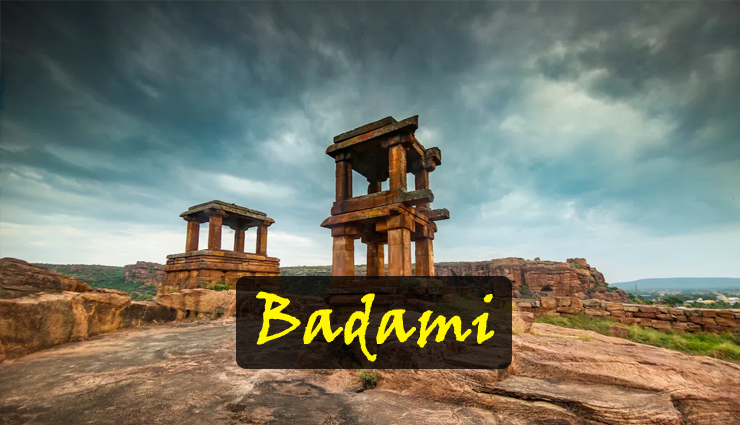
Sustaining the imprints of history and time on its form, the town of Badami is one of the top destinations to see in India if you take pleasure in old structures and history. Among the top places to visit in Badami are: –

Enclosed by red sandstone hills on all sides, Agastya Lake is a huge lake in Badami that dates back to the 5th century. The lake is considered holy and it is believed that its water carries healing properties. While the eastern bank of the Lake is dotted with Bhoothanatha temples, the South West and the North West parts house the Cave Temples and the Badami Fort, respectively.
A popular tourist place in Badami, the Lake often remains crowded with locals who come here for their bathing and cloth washing needs. The sandstones around the Lake have cuts in them to allow people to climb up the hills. The surroundings here offer amazing views of the hills encircled by historical monuments, making it one of the best places to visit in Badami.
Standing on top of the hill on the northern banks of Agastya Lake, Badami Fort is said to have been built by Chalukya ruler, Pulakesin I in 543 AD. Among the popular tourist places in Badami, this fort can be reached by taking a flight of stairs that have been created by carving out a huge hillock of red sandstone. There are two temples within the fort known as the Upper Shivalaya and Lower Shivalaya. The Upper Shivalaya is a Dravidian style structure located on the top of the hill while the Lower Shivalaya is a small two-storied structure sitting in the corner of the hill, overlooking the town of Badami. Most of the present-day fort structures had been built by Tipu Sultan. A cannon from the 16th century that was added by Tipu Sultan, is one of the top attractions within the fort.
Also known as the Badami Museum, the Archaeological Museum stands right at the foothills of the Badami Fort on the banks of Agastya Lake. Housing prehistoric artefacts including sculptures, inscriptions, and stone implements from the 6th to the 16th centuries, the Museum itself was established in the year 1976.
Among the most popular tourist places in Badami, the entrance to the museum has an idol of Nandi, the mount of Lord Shiva. Moving inside, the museum has four galleries, an open gallery at the front, and another open-air gallery in the verandah. Within these galleries, you will find excellent specimens of local sculptures, such as panels depicting Mahabharata, Ramayana, and Bhagwad Gita. One of the galleries even has a scaled model of a prehistoric cave.
Past the Badami Museum, on the banks of the Agastya Lake is the Bhoothanatha Temple which is a magnificent structure dedicated to Lord Shiva. The key promotional element of Badami tourism, the Bhoothanatha Temple was constructed in the 8th century AD and is surrounded by water on three sides.
Created in the Dravidian style of architecture, the temple is one of the most striking structures in town and definitely one of the top places to visit in Badami. The temple features a pillared Mukha Mandapa, Sabha Mandapa, and an inner sanctum where the image of Shiva (Bhoothanatha) resides. The main temple structure is accompanied by smaller shrines on the eastern and northern corners. Moving a little south from the Temple, you come across other interesting monuments carved in the hillock, including a bas-relief of Varaha, Narasimha, Durga, Trimurthi, Ganesha and various other Hindu gods.
The rock-cut cave temples of Badami are exclusively exquisite structures. Four in number and one of the top tourist places to visit in Badami, these caves display intricate carvings that depict religious teachings and various mythological events in Hinduism, Buddhism, and Jainism.
Cave No. 1
The oldest of the four caves, Cave No. 1 is dedicated to Lord Shiva and represents the Brahmanical style. This cave is best known for its fine sculptures, especially those of Shiva as Nataraja, Ardhanareeswara, and Harihara.
Cave No. 2
Cave No. 2 is dedicated to Vishnu and is the smallest of the caves. The cave portrays Lord Vishnu in different forms, some of the popular ones including Trivikrama, Varaha and Lord Krishna riding a Garuda. The ceiling and the wall brackets contain finely carved Puranic characters.
Cave No. 3
The biggest and most exquisite of all the caves, Cave No. 3 contains sculptures and paintings of both Shiva and Vishnu. An inscription within the cave indicates that it was built by Manglesha. There are various images of Lord Vishnu manifested in different forms here. There also is a beautiful mural depicting the marriage of Shiva and Parvati in the cave. The pillars within the cave feature large and detailed bracket figures.
Cave No. 4
Last but not least is Cave No. 4 that is dedicated wholly to Jain Tirthankaras. The main attraction of the cave is a sculpture of Mahavira adoring a shrine with images of different Tirthankaras, and that of Parshavnatha with a serpent at his feet.
If there is a tourist attraction that exemplifies tourism in Badami, it is the Cave temples.
Sitting right before the Bhoothanatha Temple, the Mallikarjuna Temples are among the topmost places to visit in Badami that refer to a group of temples that are dedicated to Lord Shiva. Located within an enclosed compound, these temples have been built in Phamsana or stepped pyramid style. It is believed that these temples were constructed by the Rasthrakutas and Chalukyas of Kalyani.
The outer walls of the temples are devoid of any carvings and feature plain rocks. Then there’s the tower of the inner sanctum that represents the typical Rashtrakuta style of architecture. The inner walls and pillars inside are plain too. The main shrine has three sections, including a pillared Mukha Mandapa, a surrounded Madhya Mandapa, and an inner sanctum. The temple structure too has various shrines built around it.